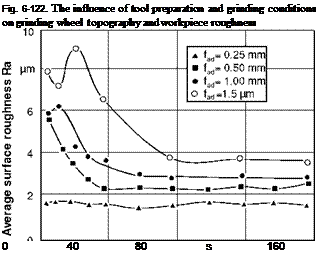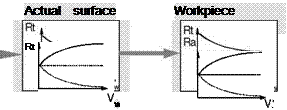The wear processes on the abrasive grain and the bond described in chapter 2.4 lead to changes to the tool topography during the grinding process.
At the beginning of the process, a rough grinding wheel surface with a multitude of sharp grain cutting edges at varying cutting edge depths can be observed. In the course of the process, i. e. with increasing material removal, a levelling on the grinding wheel topography occurs, which is attributable to a wear-related flattening of the grits. The larger number of cutting edges being engaged as well as the flatter cutting edge form is responsible for a reduction in workpiece roughness associated to an increase in cutting forces. If however the grinding wheel surface is too smooth and dull for the grinding operation before it starts, an overload of the tool can bring about grain break-out and thus an increase in the workpiece’s effective surface roughness. With increasing material removal rates, this leads to decreasing process forces and rising roughness values.
Fig. 6-122 shows schematically the influence of material removal on the effective surface roughness of the grinding wheel and workpiece roughness. In the top part of the illustration, the initial effective surface roughness of the grinding wheel is varied by an altered tool preparation or tool specification. The effective surface roughness (and the workpiece roughness contingent on it) converges however with increasing material removal rates towards a value that is nearly independent from the initial state. This quasi-stationary grinding wheel topography occurs because the mutual influence of the grinding wheel and the workpiece levels out with time at the state of equilibrium corresponding to the grinding conditions [MESS83, PAHL53, PAHL68, SCHM68, THOR73, WEIN76,]. These relations are shown in Fig. 6-123. Despite clearly different initial grinding wheel states, a constant level of roughness establishes itself on the ground workpiece with time.


 |
A 60 N 8 V
dS = 500 mm
Workpiece
Ck 45 N
dW = 138 mm
Dressing
parameters
aed= 3x 0.02 mm
Grinding
parameters
vw = 1 m/s
vc = 60 m/s
Q’w = 100 mm3/mms
Cooling lubricant
Oil
Fig. 6-123. With increasing cutting durations, the influence of engagement preparation on workpiece roughness increases
Fig. 6-120 below clarifies the influence of grinding conditions. With a lower specific material removal rate Q’w there is a refinement of the tool topography, while at a higher Q’w the effective surface roughness increases degressively. High
specific material removal rates are associated with high cutting forces and wear, so that in the course of the grinding operation a tool topography with a high effective surface roughness results.
